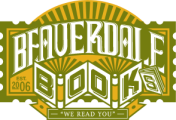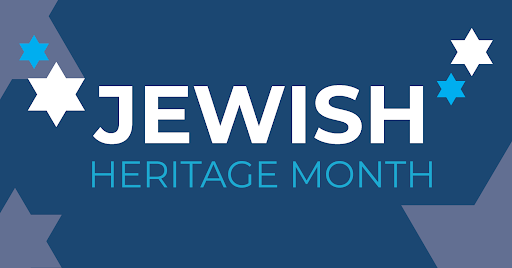
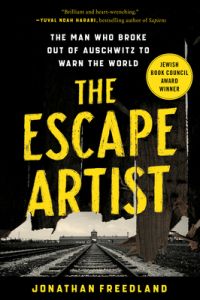
The Escape Artist: The Man Who Broke Out of Auschwitz to Warn the World
By Jonathan Freedland
Nonfiction
Harper Paperbacks
A complex hero. A forgotten story. The first witness to reveal the full truth of the Holocaust . . . Award-winning journalist and bestselling novelist Jonathan Freedland tells the astonishing true story of Rudolf Vrba, the man who broke out of Auschwitz to warn the world of a truth too few were willing to hear. In April 1944, Rudolf Vrba became one of the very first Jews to escape from Auschwitz and make his way to freedom—among only a tiny handful who ever pulled off that near-impossible feat. He did it to reveal the truth of the death camp to the world—and to warn the last Jews of Europe what fate awaited them. Against all odds, Vrba and his fellow escapee, Fred Wetzler, climbed mountains, crossed rivers, and narrowly missed German bullets until they had smuggled out the first full account of Auschwitz the world had ever seen—a forensically detailed report that eventually reached Franklin Roosevelt, Winston Churchill, and the Pope. And yet too few heeded the warning that Vrba had risked everything to deliver. Though Vrba helped save two hundred thousand Jewish lives, he never stopped believing it could have been so many more. This is the story of a brilliant yet troubled man—a gifted “escape artist” who, even as a teenager, understood that the difference between truth and lies can be the difference between life and death. Rudolf Vrba deserves to take his place alongside Anne Frank, Oskar Schindler, and Primo Levi as one of the handful of individuals whose stories define our understanding of the Holocaust.
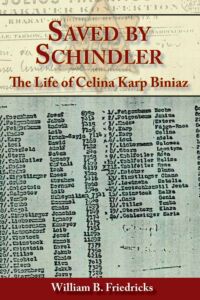
Celina Karp Biniaz was just eight years old when the Germans invaded her homeland of Poland in 1939. Over the next six years, the child from Krakow endured the Holocaust as the Nazis took away her schooling and civil rights, then herded her and her family into a ghetto. Life grew worse when the ghetto was liquidated, and the family was sent to Plaszów, a slave labor/concentration camp where they lived in constant fear, witnessing unspeakable horrors. Ultimately, Celina and her parents landed on Schindler’s list, but before being sent to safety at Schindler’s factory, Celina spent several terrifying weeks at Auschwitz where she faced down the infamous Dr. Josef Mengele. When the war ended, she and her family eventually made their way to the United States, where Celina got on with her life. With great strength and resilience, she moved forward and embraced the American dream. She finished her education, got married, had a family, and eventually enjoyed a career in teaching. But she kept her Holocaust experience a secret because the years were too terrible to describe, and she did not believe anyone would understand. That all changed with Steven Spielberg’s film Schindler’s List, which brought the Holocaust and the story of Oskar Schindler to millions around the world. The movie prompted Celina to confront her painful past and begin speaking publicly about it. As she often explains, “Oskar Schindler gave me my life, but Steven Spielberg gave me my voice.”

Based on the acclaimed HBO documentary, the astonishing true story of how one American couple transported fifty Jewish children from Nazi-occupied Austria to America in 1939—the single largest group of unaccompanied refugee children allowed into the United States—for readers of In the Garden of Beasts and A Train in Winter. In early 1939, America’s rigid immigration laws made it virtually impossible for European Jews to seek safe haven in the United States. As deep-seated anti-Semitism and isolationism gripped much of the country, neither President Roosevelt nor Congress rallied to their aid. Yet one brave Jewish couple from Philadelphia refused to silently stand by. Risking their own safety, Gilbert Kraus, a successful lawyer, and his stylish wife, Eleanor, traveled to Nazi-controlled Vienna and Berlin to save fifty Jewish children. Steven Pressman brought the Kraus’s rescue mission to life in his acclaimed HBO documentary, 50 Children . In this book, he expands upon the story related in the hour-long film, offering additional historical detail and context to offer a rich, full portrait of this ordinary couple and their extraordinary actions. Drawing from Eleanor Kraus’s unpublished memoir, rare historical documents, and interviews with more than a dozen of the surviving children, and illustrated with period photographs, archival materials, and memorabilia, 50 Children is a remarkable tale of personal courage and triumphant heroism that offers a fresh, unique insight into a critical period of history.

The Daughter of Auschwitz: A Memoir
By Tova Friedman, Malcolm Brabant
Memoir
Hanover Square
A powerful memoir by one of the youngest ever survivors of Auschwitz, Tova Friedman, following her childhood growing up during the Holocaust and surviving a string of near-death experiences in a Jewish ghetto, a Nazi labor camp, and Auschwitz.
Tova Friedman was only four years old when she was sent to a Nazi labor camp at the start of World War II. While friends and family were murdered in front of her eyes, the only weapon that Tova and her parents possessed was the primal instinct to survive at all costs. Fate intervened when, at the age of six, Tova was sent to a gas chamber, but walked out alive, saved by German bureaucracy. Not long afterwards, she cuddled a warm corpse to hide from Nazis rounding up prisoners for the Death March to Germany.
In this heartrending, lyrical account of a young girl’s survival during the Holocaust, Tova Friedman, together with Malcolm Brabant, chronicles the atrocities she witnessed while at Auschwitz, a family secret that sheds light on the unpalatable choices Jews were forced to make to survive, and ultimately, the sources of hope and courage she and her family found to persist against all odds.
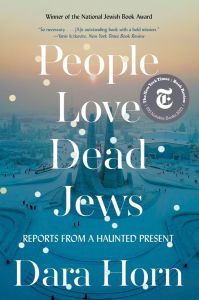
People Love Dead Jews: Reports from a Haunted Present
By Dara Horn
Nonfiction
W. W. Norton & Company
A startling and profound exploration of how Jewish history is exploited to comfort the living.
Renowned and beloved as a prizewinning novelist, Dara Horn has also been publishing penetrating essays since she was a teenager. Often asked by major publications to write on subjects related to Jewish culture―and increasingly in response to a recent wave of deadly antisemitic attacks―Horn was troubled to realize what all of these assignments had in common: she was being asked to write about dead Jews, never about living ones. In these essays, Horn reflects on subjects as far-flung as the international veneration of Anne Frank, the mythology that Jewish family names were changed at Ellis Island, the blockbuster traveling exhibition Auschwitz , the marketing of the Jewish history of Harbin, China, and the little-known life of the “righteous Gentile” Varian Fry. Throughout, she challenges us to confront the reasons why there might be so much fascination with Jewish deaths, and so little respect for Jewish lives unfolding in the present. Horn draws upon her travels, her research, and also her own family life―trying to explain Shakespeare’s Shylock to a curious ten-year-old, her anger when swastikas are drawn on desks in her children’s school, the profound perspective offered by traditional religious practice and study―to assert the vitality, complexity, and depth of Jewish life against an antisemitism that, far from being disarmed by the mantra of “Never forget,” is on the rise. As Horn explores the (not so) shocking attacks on the American Jewish community in recent years, she reveals the subtler dehumanization built into the public piety that surrounds the Jewish past―making the radical argument that the benign reverence we give to past horrors is itself a profound affront to human dignity. Now including a reading group guide.
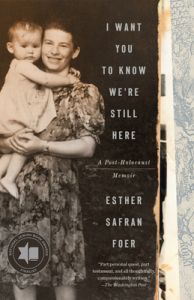
I Want You to Know We’re Still Here: A Post-Holocaust Memoir
By Esther Safran Foer
Memoir
Crown
Esther Safran Foer grew up in a home where the past was too terrible to speak of. The child of parents who were each the sole survivors of their respective families, for Esther the Holocaust loomed in the backdrop of daily life, felt but never discussed. The result was a childhood marked by painful silences and continued tragedy. Even as she built a successful career, married, and raised three children, Esther always felt herself searching.
So when Esther’s mother casually mentions an astonishing revelation–that her father had a previous wife and daughter, both killed in the Holocaust–Esther resolves to find out who they were, and how her father survived. Armed with only a black-and-white photo and a hand-drawn map, she travels to Ukraine, determined to find the shtetl where her father hid during the war. What she finds reshapes her identity and gives her the opportunity to finally mourn.
I Want You to Know We’re Still Here is the poignant and deeply moving story not only of Esther’s journey but of four generations living in the shadow of the Holocaust. They are four generations of survivors, storytellers, and memory keepers, determined not just to keep the past alive but to imbue the present with life and more life.
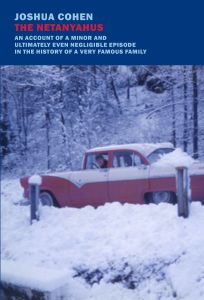
The Netanyahus: An Account of a Minor and Ultimately Even Negligible Episode in the History of a Very Famous Family
By Joshua Cohen
Fiction
New York Review Books
Corbin College, not quite upstate New York, winter 1959–1960: Ruben Blum, a Jewish historian—but not an historian of the Jews—is co-opted onto a hiring committee to review the application of an exiled Israeli scholar specializing in the Spanish Inquisition. When Benzion Netanyahu shows up for an interview, family unexpectedly in tow, Blum plays the reluctant host to guests who proceed to lay waste to his American complacencies. Mixing fiction with nonfiction, the campus novel with the lecture, The Netanyahus is a wildly inventive, genre-bending comedy of blending, identity, and politics that finds Joshua Cohen at the height of his powers.
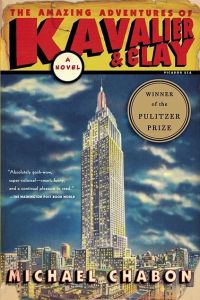
The Amazing Adventures of Kavalier & Clay
By Michael Chabon
Fiction
Picador USA
Joe Kavalier, a young Jewish artist who has also been trained in the art of Houdini-esque escape, has just smuggled himself out of Nazi-invaded Prague and landed in New York City. His Brooklyn cousin Sammy Clay is looking for a partner to create heroes, stories, and art for the latest novelty to hit America – the comic book. Drawing on their own fears and dreams, Kavalier and Clay create the Escapist, the Monitor, and Luna Moth, inspired by the beautiful Rosa Saks, who will become linked by powerful ties to both men. With exhilarating style and grace, Michael Chabon tells an unforgettable story about American romance and possibility.

Koshersoul: The Faith and Food Journey of an African American Jew
By Michael W. Twitty
Memoir
Amistad
In Koshersoul, Michael W. Twitty considers the marriage of two of the most distinctive culinary cultures in the world today: the foods and traditions of the African Atlantic and the global Jewish diaspora. To Twitty, the creation of African-Jewish cooking is a conversation of migrations and a dialogue of diasporas offering a rich background for inventive recipes and the people who create them.
The question that most intrigues him is not just who makes the food, but how the food makes the people. Jews of Color are not outliers, Twitty contends, but significant and meaningful cultural creators in both Black and Jewish civilizations. Koshersoul also explores how food has shaped the journeys of numerous cooks, including Twitty’s own passage to and within Judaism.
As intimate, thought-provoking, and profound as The Cooking Gene, this remarkable book teases the senses as it offers sustenance for the soul.
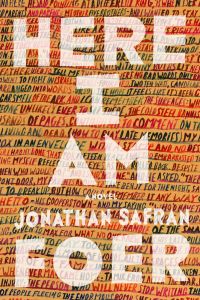
Here I Am
By Jonathan Safran Foer
Fiction
Hamish Hamilton
In the book of Genesis, when God calls out, “Abraham!” before ordering him to sacrifice his son, Isaac, Abraham responds, “Here I am.” Later, when Isaac calls out, “My father!” before asking him why there is no animal to slaughter, Abraham responds, “Here I am.”
How do we fulfill our conflicting duties as father, husband, and son; wife and mother; child and adult? Jew and American? How can we claim our own identities when our lives are linked so closely to others? These are the questions at the heart of Jonathan Safran Foer’s first novel in eleven years – a work of extraordinary scope and heartbreaking intimacy.
Unfolding over four tumultuous weeks in present-day Washington, D.C., Here I Am is the story of a fracturing family in a moment of crisis. As Jacob and Julia Bloch and their three sons are forced to confront the distances between the lives they think they want and the lives they are living, a catastrophic earthquake sets in motion a quickly escalating conflict in the Middle East. At stake is the meaning of home – and the fundamental question of how much aliveness one can bear.
Showcasing the same high-energy inventiveness, hilarious irreverence, and emotional urgency that readers loved in his earlier work, Here I Am is Foer’s most searching, hard-hitting, and grandly entertaining novel yet. It not only confirms Foer’s stature as a dazzling literary talent but reveals a novelist who has fully come into his own as one of our most important writers.
